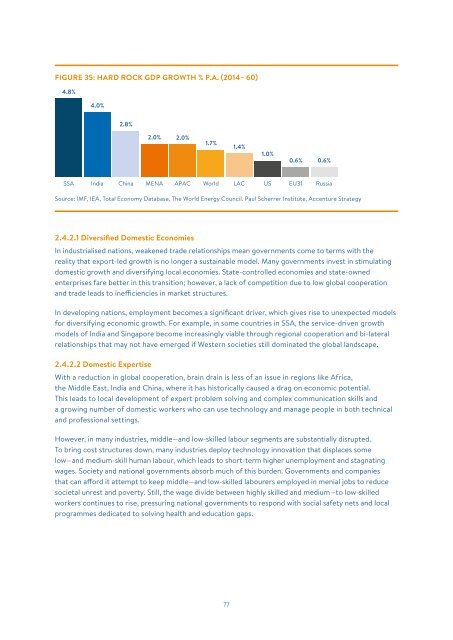World Energy Scenarios
b9Sz9NC
b9Sz9NC
Create successful ePaper yourself
Turn your PDF publications into a flip-book with our unique Google optimized e-Paper software.
Figure 35: Hard Rock% GDP Growth from 2014 to 2060<br />
FIGURE 35: HARD ROCK GDP GROWTH % P.A. (2014– 60)<br />
4.8%<br />
4.0%<br />
2.8%<br />
2.0%<br />
2.0%<br />
1.7%<br />
1.4%<br />
1.0%<br />
0.6%<br />
0.6%<br />
SSA<br />
India<br />
China<br />
MENA<br />
APAC<br />
<strong>World</strong><br />
LAC<br />
US<br />
EU31<br />
Russia<br />
Source: IMF, IEA, Total Economy Database, The <strong>World</strong> <strong>Energy</strong> Council. Paul Scherrer Institute, Accenture Strategy<br />
2.4.2.1 Diversified Domestic Economies<br />
In industrialised nations, weakened trade relationships mean governments come to terms with the<br />
reality that export-led growth is no longer a sustainable model. Many governments invest in stimulating<br />
domestic growth and diversifying local economies. State-controlled economies and state-owned<br />
enterprises fare better in this transition; however, a lack of competition due to low global cooperation<br />
and trade leads to inefficiencies in market structures.<br />
In developing nations, employment becomes a significant driver, which gives rise to unexpected models<br />
for diversifying economic growth. For example, in some countries in SSA, the service-driven growth<br />
models of India and Singapore become increasingly viable through regional cooperation and bi-lateral<br />
relationships that may not have emerged if Western societies still dominated the global landscape.<br />
2.4.2.2 Domestic Expertise<br />
With a reduction in global cooperation, brain drain is less of an issue in regions like Africa,<br />
the Middle East, India and China, where it has historically caused a drag on economic potential.<br />
This leads to local development of expert problem solving and complex communication skills and<br />
a growing number of domestic workers who can use technology and manage people in both technical<br />
and professional settings.<br />
However, in many industries, middle—and low-skilled labour segments are substantially disrupted.<br />
To bring cost structures down, many industries deploy technology innovation that displaces some<br />
low—and medium-skill human labour, which leads to short-term higher unemployment and stagnating<br />
wages. Society and national governments absorb much of this burden. Governments and companies<br />
that can afford it attempt to keep middle—and low-skilled labourers employed in menial jobs to reduce<br />
societal unrest and poverty. Still, the wage divide between highly skilled and medium—to low-skilled<br />
workers continues to rise, pressuring national governments to respond with social safety nets and local<br />
programmes dedicated to solving health and education gaps.<br />
77


